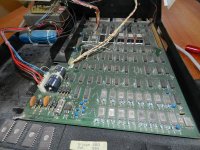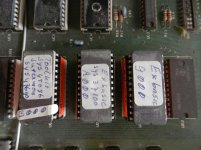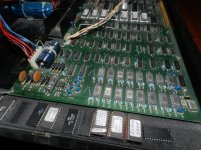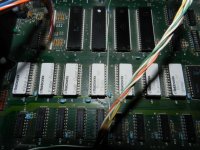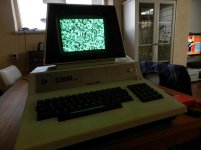Denniske1976
Experienced Member
Hi all,
I've just gotten hold of a PET (CBM 3032) from someone about 30 minutes ago Looks really cool and it seems to be a very early one. Most chips have 1977 date code on them. Still have to go about and clean it, but I thought "Let's power it on and see what happens". Well, I can see the CRT glowing trough the back of the monitor vent and I can hear the current/power but I get no screen. I'm not too familiar with these things but there's supposed to come something like "BASIC Ready" and stuff (like a Commodore 64 right?) up on screen?
Looks really cool and it seems to be a very early one. Most chips have 1977 date code on them. Still have to go about and clean it, but I thought "Let's power it on and see what happens". Well, I can see the CRT glowing trough the back of the monitor vent and I can hear the current/power but I get no screen. I'm not too familiar with these things but there's supposed to come something like "BASIC Ready" and stuff (like a Commodore 64 right?) up on screen?
Weird thing is when I switch it off and on again I can actually see an image on screen for about 1/10th of a second. It's the whole screen filled with ASCII chararcters from top to bottom and left to right... so I know the screen ain't dead. Could this be some chip that's not good? One of the BASIC chips maybe? Because when I opened up the case (very cool, like the hood of a car LOL) there's like about 12 or maybe even more different BASIC chips stuck on some foam. I'll get some pictures tomorrow and post them up here anyways.
Also: were these things also available as a KIT??!! Because from what I've seen online, mine looks nothing like the other PETs. Well, of course the case is the same but the face plate of mine is silver, with the owner's name on it so it looks as if he made that himeself. Also there's a KEY at the right in the face plate (key-lock??). Don't see that on any of the PETs I've seen online. Keyboard is the same though. It also has a serial number but there's no COMMODORE sticker or label or anything to find on and in the whole machine (not even on the mainboard). That's really weird AFAIC but maybe that was common back then? It does have cassette port, IEE-488 or something? and one very wide connector (also have cables for that so don't know what goes on it but the cables were included).
Anyhoo, the owner told me he put it in storage about 25 years ago and it was working and it's been up in the attick ever since... I checked for loose chips and they all seem to be fine. Just don't know how to check for bad chips ;-)
HELP!?!?! Would really like to get this up and running... I'm more of an "8088/8086 guy" but I always loved PETs for their appearance and I understand they were quite the thing back in the 70ies.
Thanx for reading and have a good one!
Dennis
I've just gotten hold of a PET (CBM 3032) from someone about 30 minutes ago
Weird thing is when I switch it off and on again I can actually see an image on screen for about 1/10th of a second. It's the whole screen filled with ASCII chararcters from top to bottom and left to right... so I know the screen ain't dead. Could this be some chip that's not good? One of the BASIC chips maybe? Because when I opened up the case (very cool, like the hood of a car LOL) there's like about 12 or maybe even more different BASIC chips stuck on some foam. I'll get some pictures tomorrow and post them up here anyways.
Also: were these things also available as a KIT??!! Because from what I've seen online, mine looks nothing like the other PETs. Well, of course the case is the same but the face plate of mine is silver, with the owner's name on it so it looks as if he made that himeself. Also there's a KEY at the right in the face plate (key-lock??). Don't see that on any of the PETs I've seen online. Keyboard is the same though. It also has a serial number but there's no COMMODORE sticker or label or anything to find on and in the whole machine (not even on the mainboard). That's really weird AFAIC but maybe that was common back then? It does have cassette port, IEE-488 or something? and one very wide connector (also have cables for that so don't know what goes on it but the cables were included).
Anyhoo, the owner told me he put it in storage about 25 years ago and it was working and it's been up in the attick ever since... I checked for loose chips and they all seem to be fine. Just don't know how to check for bad chips ;-)
HELP!?!?! Would really like to get this up and running... I'm more of an "8088/8086 guy" but I always loved PETs for their appearance and I understand they were quite the thing back in the 70ies.
Thanx for reading and have a good one!
Dennis

